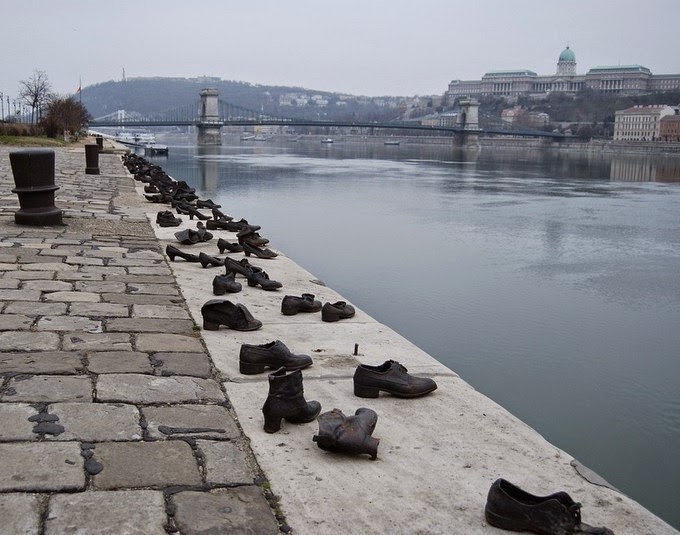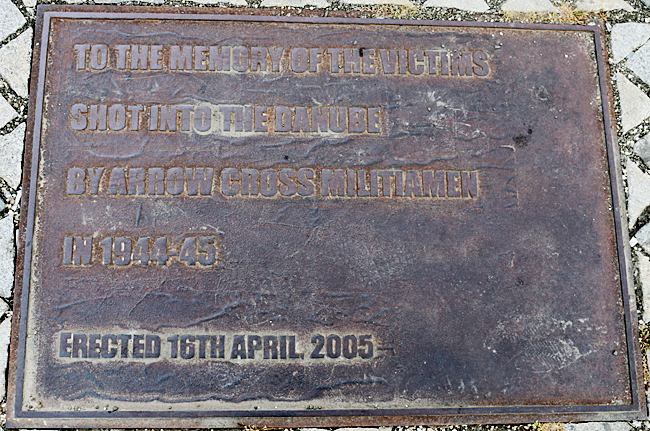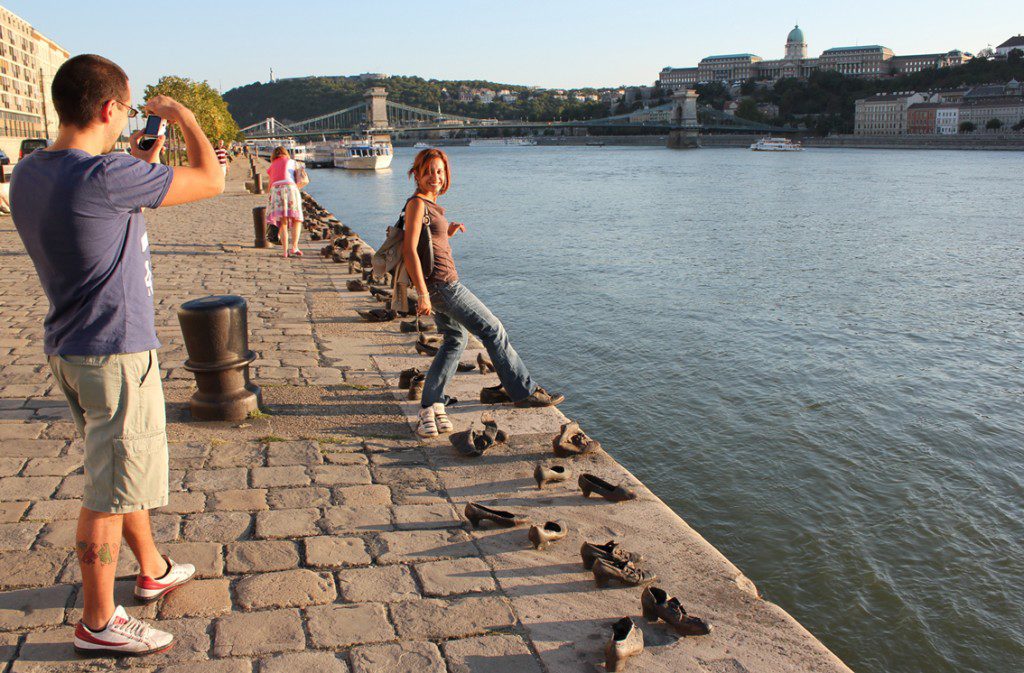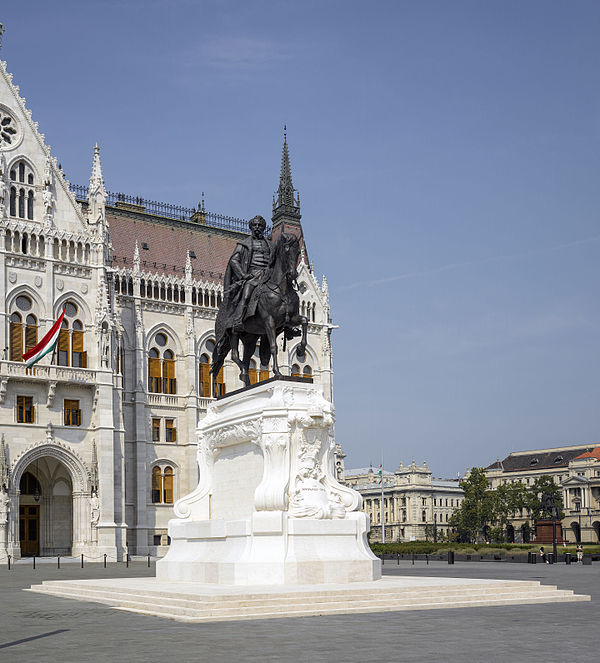In case you’re wondering, today’s story takes place on Thursday, 25 August and I left the U.S. on 7 August so, in the context of the trip, we’ll spend today and tomorrow in Budapest and then I’ll be home. I don’t mean to be saucy but there’s plenty of Pest left to explore. Oh, spoiler alert: It’s not going to be all fun and games.
Empty Shoes
With the three amigas off to Szentendre for the day, I decided it was time to atone for my lascivious – if somewhat infantile – sniggering over phallic bottle openers yesterday and Pat graciously agreed to join me so we set out to explore some of the darker moments in Hungarian history that are memorialized in places around Budapest. Well, around Pest.
In an earlier history lesson, I noted that after the Germans invaded Hungary and installed a puppet regime in March 1944 headed by Ferenc Szálasi the leader of the pro-Nazi Arrow Cross Party, they had deported more than 430,000 Hungarian Jews to concentration camps by June of that year. Recall also that during the Red Army’s assault, siege, and eventual “liberation” of Budapest that stretched from the end of October 1944 to mid-February 1945, the Arrow Cross, rounded up and executed an estimated 15,000 Jews who had avoided the deportation. Many of those came in their final desperate days when the Soviet victory appeared inevitable.
A shocking number of these executions took place along the banks of the Danube River. Militiamen from the Arrow Cross would round up scores of Jews, lead them to the banks of the Danube and force them to remove their shoes before executing them. Why, you might wonder, would they have the victims remove their shoes? The likely answer is that it was winter and wartime in a city under siege. Shoes were a valuable commodity. They could be worn. Or traded on the black market.
Often, if the shoes themselves were too worn or too small the killers would sometimes remove the laces and use them to tie the hands of their victims. Sometimes they would use rope to tie two or three people together and shoot only one who would then fall into the river dragging living people with him who would then drown or, more likely, die of hypothermia. They let the river become the Jewish cemetery and wash the bodies away.
Zsuzsanna Ozsváth was among the few survivors of that winter. A child at the time, Ozsváth and her family were hidden by a former nursemaid, Erzsi Fajo. Ozsváth eventually emigrated to the United States where she has become the Leah and Paul Lewis Chair of Holocaust Studies and professor of literature and history of ideas at the University of Texas, Dallas. In her memoir When the Danube Ran Red, she described the events of one night:
“I heard a series of popping sounds. Thinking the Russians had arrived, I slunk to the window. But what I saw was worse than anything I had ever seen before, worse than the most frightening accounts I had ever witnessed. Two Arrow Cross men were standing on the embankment of the river, aiming at and shooting a group of men, women and children into the Danube – one after the other, on their coats the Yellow Star. I looked at the Danube. It was neither blue nor gray but red. With a throbbing heart, I ran back to the room in the middle of the apartment and sat on the floor, gasping for air.”
A simple memorial, conceived by film director Can Togay and created by sculptor Gyula Pauer, was installed along the banks of the river in sight of the Hungarian Parliament some 60 years after the events of that terrible winter. Equally simple, the memorial’s name is Shoes Along the Danube Bank.
Patricia and I stood together quietly, each allowing the memorial and the silence of the river flowing past to reflect on its meaning in our own way. I broke the silence by commenting to Pat that I hadn’t seen any sort of marker or explanation and that someone happening upon it without foreknowledge could easily misinterpret its meaning and purpose. While looking for a photo to share, I discovered both a refutation and confirmation of this statement. The refutation came when I located this photo:
Apparently, it’s not the only one. There are three separate places on the memorial where these cast iron markers are embedded in the bricks – one each in Hungarian, English and Hebrew.
Confirmation came in the form of another photo I found from Roz Mortimer’s project Reduced to Silence. This is how she describes it on her website:
“Reduced to Silence is an exploration into memory, atrocity and landscape.
At first I was interested in places that had witnessed catastrophic events, yet remained without any formal memorial. I wondered if these unmarked landscapes might hold any tangible traces or memory of the events they had witnessed, and how I might translate those traces through film and photography.As my research progressed the project has become less about memory, and more about a culture of forgetting. I began to think about why societies choose to remember and memorialise some events, yet choose to forget others.”
With respect to Shoes Along the Danube Bank, she had this photo that I think speaks for itself.
Statues and other distractions
I noted above that Shoes Along the Danube Bank is within sight of the Hungarian Parliament building so Pat and I decided that should be our next stop. We’d get there but only after having our attention diverted along the way.
Soon after we climbed the stairs to return to street level, we were drawn to a sculpture on the edge of Kossuth Square
that, with the phrase written on marble, seemed to be more than a tribute to a weary worker. A bit of research once I got home revealed that the man with hat in hand is the poet József Attila. He was born on 11 April 1905 and died – possibly accidentally and possibly by suicide – when he was crushed by a train on 3 December 1937. More than one source called him the most internationally famous modern Hungarian poet. Even after reading this, I had no notion of who he was.
The youngest of three children, Attila was born in the slums of Budapest, his father was an itinerant Romanian worker in a soap factory who disappeared when Attila was three years old. His mother, who worked as a laundry woman and died in 1919 at age 43, struggled to support her family. Attila and his sisters often found themselves in foster homes. Rising above these very humble beginnings, Attila published his first volume of poetry when he was just 17 years old.
One of Attila’s most famous poems is called A Dunánál – By the Danube. Literature is inherently difficult to translate and poetry even more so. Here are two quite different translations that I could find of the first stanza of that work:
I sit on the quayside by the landing,
a melon rind comes drifting on the flow,
I reflect on my fate, quietly observing
surface ripples, sensing the calm below;
as if my heart had been at the source
of the troubled, wise old Danube, mighty force.
***************
As I sat on the bottom step of the wharf,
A melon-rind flowed by with the current;
Wrapped in my fate I hardly heard the chatter
Of the surface, while the deep was silent.
As if my own heart had opened its gate:
The Danube was turbulent, wise and great.
Attila had, at one time, been a member of the then illegal Communist Party and the memorial above was constructed in 1980 toward the end of the communist era and the rule of János Kadar. Its initial installation was closer to Kossuth Square. When the square was remade in 2010, the statue was moved to its current spot. Then, with the rise of a more right-wing government led by Viktor Orbán, the statue became somewhat controversial and proposals arose to move it again.
Thus far, the efforts of artists and intellectuals (and perhaps the prohibitive cost of moving it) have kept the memorial in this very appropriate spot. It’s also noteworthy that Hungary’s National Day of Poetry is 11 April – Attila’s birthday.
After spending some time with József Attila, we continued our walk to the Parliament building. If you look back at the photo of the memorial to Attila, you can see one side of Hungary’s Parliament behind it. What you can’t see is the statue of Gyula Andrássy. But now you can and I’ll introduce you to Andrássy (seen below) in the next post.




